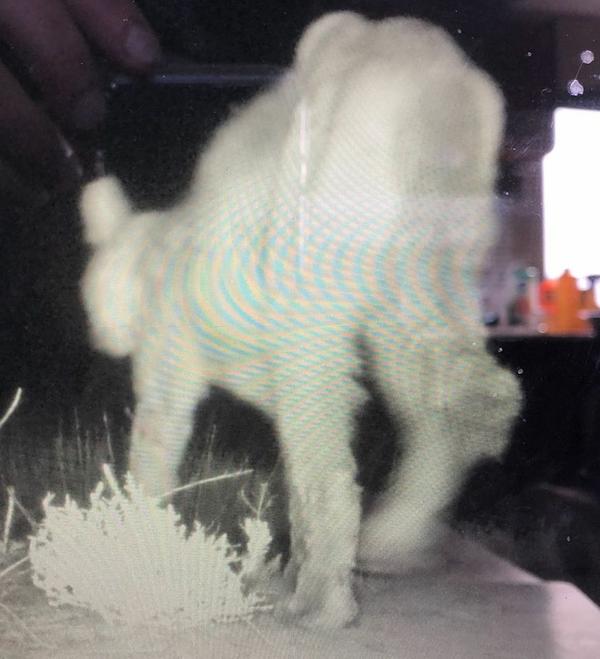
On an exceptional chilly and gloomy late morning of Tuesday, April 16, 1935, Juan, the Portuguese fisherman quietly rowed his 16-foot saltwater dory back through wisps of fog to his home vessel. Home was a two-masted wooden fishing schooner, anchored in nutrient rich waters off Maritime Canada’s Grand Banks, one of the richest cod and haddock fisheries in the world. Her home port was Gloucester, Massachusetts. Portuguese and Spanish crew members were common in that era; their upbringing in a cod fishing trade dominated by Portugal since the 1300’s made them natural crew members in the North Atlantic fishery.
It was a profitable morning. His small wooden craft sat low on the quietly rolling swells of the ocean. Codfish that he caught nearly filled the boat to the gunwales. And this year, the price was looking good. His commensurate pay would be likewise.
But this year was unlike any other. An unsettling coating of dust found the deck of their ships and even the fish that filled Juan’s dory. This morning, there was nearly a quarter inch of fine dirt on the rising and falling deck of their ship. And the temperatures were off by tens of degrees. Normally, the Gulf Stream waters brought temperatures that offered a warmer respite to the bleak continental climate of winter on the mainland, but the dust in the atmosphere prevented the sun from showing up strong.
What Juan did not understand was that the elevated (and long awaited) price of cod and haddock was directly related to the dust that dirtied deck and fish. But that was another story; it was a tale of death and destruction. Unfolding in all of its severity 3000 miles away in the Southern Plains states of Oklahoma, Kansas and Texas were getting hammered. Other states surrounding those were also affected, but in those three states the extensive destruction and the despair wrought by it was by far the greatest.
The peak proportions of the tale forced their way into headlines worldwide just two days before Juan found dust on the deck of his schooner. It would forever be called Black Sunday. It was April 14, 1935.
 Â The morning dawned clear enough in the Oklahoma Panhandle. The small town of Boise City, with a population of nearly 1000, celebrated the arrival of a beautiful calm spring day. Warmth and blue skies lifted the sprits of the locals. The weather had been a little harrowing, nearly rainless with dust borne winds and tumultuous weather thus far in April of 1935. Optimism flourished on this, a different day, and the faithful gathered up and filled the seats of the Baptist church, greeting each other in their Sunday best.
 The morning dawned clear enough in the Oklahoma Panhandle. The small town of Boise City, with a population of nearly 1000, celebrated the arrival of a beautiful calm spring day. Warmth and blue skies lifted the sprits of the locals. The weather had been a little harrowing, nearly rainless with dust borne winds and tumultuous weather thus far in April of 1935. Optimism flourished on this, a different day, and the faithful gathered up and filled the seats of the Baptist church, greeting each other in their Sunday best.
Farmers, near destitute from several years of drought since 1930 combined with a wheat market gone bust, limped into town in older, well-worn Model-Ts or horse drawn wagons, hoping to receive a balm for their distressed spirits. Surely, this quiet day that dawned with birdsong would mark a new beginning. Things couldn’t get worse, they reasoned. The previous summer of 1934 was burned into their memories by over 45 consecutive days where the mercury rose above 100 degrees during the months of July and August. Crops wilted and simply blew away. Cattle perished from heat stress, lack of water, and starvation.
It was the same story throughout the lower plains. Millions of cattle had perished in the short grass plains from Colorado to Arkansas in 1934. Dust storms carried away precious topsoil, exposed to the gale force winds created when the commonplace collision of fronts created tornadoes over the high plains.
Several threads must be pulled together to understand what happened. The 1920s was the first time the soil had been exposed on such a grand scale as this. Driven by an insatiable appetite for wheat spurred by World War I, grain prices soared higher and higher, and pristine prairie sod was ripped open as fast as plows could be pulled. The wheat market whipped the world into a green gold-rush to plant every square foot to grain.
The loss of native prairie grass pushed cattle to more marginal, high elevation ranges along the New Mexico and Colorado front, where they ate everything in sight- too many cattle on too little ground.
When the wheat market collapsed in the late teens and the early twenties, the combined effect was damning. With no remaining soil organic matter and no plants to hold the now fallow soils along with the loss of grass to overgrazing on rangelands, the topsoil blew.
Then, in 1926, a ten year drought struck the Great Plains. Precipitation was in some areas a tenth of what was considered normal rainfall. Rivers like the Cimarron, the Red, and the Arkansas, usually running full in the spring with snowmelt from the Rockies, were parched and cracked this April.
And the culmination of all ushered in a new phenomenon: the dust storm, soon to become known as the Black Blizzard.
 Some 50 such storms were recorded before Sunday, April 14, 1935, over the previous dry summers. And unbeknownst to the worshippers at Boise City Baptist, as they held their hymnals in song, a Canadian cold front slipping down along the Rocky Mountain front had already collided with a hot air mass over the Dakotas. The result was 50 and 60 mile an hour winds on a front that roared southeast, nearly 1000 miles wide.
Some 50 such storms were recorded before Sunday, April 14, 1935, over the previous dry summers. And unbeknownst to the worshippers at Boise City Baptist, as they held their hymnals in song, a Canadian cold front slipping down along the Rocky Mountain front had already collided with a hot air mass over the Dakotas. The result was 50 and 60 mile an hour winds on a front that roared southeast, nearly 1000 miles wide.
As the attendees emptied the church, greeting each other in their Sunday attire, they made plans for dinner and a lovely Sunday afternoon. But just as they parted ways, an unsettling cool breeze stirred from the Northwest. In another 15 minutes, breeze became wind. The temperature began to plummet, and in two hours, had dropped from a balmy 70 to 40. With it, the wind increased, until in the late afternoon phones began to ring from friends and neighbors in Kansas to the North. A dust storm was coming, they said. A black blizzard. And it was a big one.
People literally ran for their homes. Some stopped in terror, frozen, as the specter of the storm erupted over the flat horizon, rising from the northwest. It was like a huge cumulus cloud, but black, reaching all across the expanse of the open former prairie. The rolling cloud would reach up to 10,000 feet into the atmosphere, and eyewitnesses said that it rolled over on itself, like a breaking wave.
Some wouldn’t make it home in time; their automobile engines would choke and die in the dust, the static electricity created by the swirling dust killing the simple electrical systems of their cars. Radios changed to static from electrical charges ripping through the air. Those who made it to their homes stuffed clothing to jam cracks in windows and doors; wetting clothing with what water they had to masking themselves and their children from the suffocating dust.
Overtaken by a storm traveling faster than a freight train, all went black. The landscape was dark as midnight; streetlights would light the way in town; outside of town, if a vehicle was still running, headlights could show the way until inches, then feet of dust obscured the line between road and field. Cars careened off roads into borrow pits and fields, intractably stuck. People who left their vehicles perished or suffered for the rest of life from dust inhalation.
 Â This one Black Sunday storm lifted and transported over 300 million tons of soil into the atmosphere. Some of it dusted ships like Juan’s with over a half an inch on decks that sailed across the Atlantic Ocean, 4000 miles distant. The volume of soil that moved in that one day exceeded the entire water volume of Lake Erie.
 This one Black Sunday storm lifted and transported over 300 million tons of soil into the atmosphere. Some of it dusted ships like Juan’s with over a half an inch on decks that sailed across the Atlantic Ocean, 4000 miles distant. The volume of soil that moved in that one day exceeded the entire water volume of Lake Erie.
It is no wonder that entire herds of cattle died, not only from dust inhalation, but starvation. If grass was present before the storms, it was buried by them. Fence posts over 6 feet tall protruded from deposited dust and dirt by only inches. Millions of cattle and sheep would succumb. Thousands of people perished as well, if not from direct asphyxiation, then through long chronic cases of “dust pneumonia.” Destitute, they were hopelessly stranded on the land on which they lived. There was simply no way out.
In fact, contrary to popular belief, they did not make up the “Okies,” or Grapes of Wrath migrators that John Steinbeck writes of. Those migrants were from farther east, and although marginal from the drought and lack of opportunity, they had resources enough to move. But here, in the heart of the Dust Bowl, over 75 percent of the people remained there and died there, unable to leave after the years in the worst of a geography of circumstance left them hopelessly destitute.
As is always the case in the cycles of economic woe, some would benefit. Juan the Portuguese fisherman would, for one. With the US beef supply crashing from a loss of Great Plains cattle, Americans would eat more fish in 1935 than ever before, the start of the escalation of America’s taste for fish such that by 1992, the apparently never-ending abundant cod would nearly be brought to extinction.
President Franklin D. Roosevelt took immediate action, spurred on by Black Friday. After all, dust from that storm literally darkened the hallowed halls of DC, leaving inches on the Capital steps. Within two weeks, the federal government initiated plans to create a Soil Conservation Service. Roosevelt subsequently stated the oft repeated quote, “the Nation that destroys its soil destroys itself.”
And that conservation movement of set-asides, windbreaks, and cover crops effectively halted, for now, the dust storm phenomenon. And dirt stopped hitchhiking on prevailing winds on a cross country tour. But is it over? Are our soils in great shape now? Soil conservation has dramatically slowed or stopped the movement of soil in air (or water on its way to the Gulf of Mexico) but is our dirt soil, and not just dirt?
Definition required: dirt is nonliving mineral material in the form of everything from decomposed rock rubble to finer clays and silts. There is no living organic component. Soil, on the other hand, lives. It is a living, breathing organism, comprised of thousands of types of micro and macro biota from bacteria and paramecium to earthworms and our own Columbian ground squirrels.
But what happens to soil that is used for annual crops? Annual crops depend on tilling, herbicides, fungicides, insecticides and fertilizers, all of which have a significant impact on soil biota. Tilling physically tears the threadlike filaments of arbuscular mycorrhizal fungi, which are critical to effective uptake of water and nutrients by plants. In pre-1960 agricultural systems, cropping systems were usually interwoven with pasture rotations and livestock, providing a break from annual tilling.
Herbicide use rose rapidly from 196 million pounds of active ingredient in 1960 to a high of 632 million pounds in 1981, and the combined total of herbicides, insecticides, and fungicides was nearly a billion pounds in 2012. Globally, use of fertilizers has increased more than 10-fold since 1950. On a per acre basis in the United States, use of the three major fertilizer nutrients increased from 46.2 nutrient pounds per acre per year (lb/acre/yr) in 1960 to 146 lb/acre/yr in 2004, an increase of 215 percent. Total crop acreages have actually dropped slightly since 1960, which means that the intensity of agrochemical agriculture on a per acre basis has increased many-fold.
 Unfortunately, no one has been measuring soil organic matter trends on a national level, but the few long-term studies available show that soil organic matter declines in fields that are continuously cropped, no matter how much fertilizer and soil amendments are added. The bottom line here is that, if soil microbes are not happy, then the appropriate nutrients will not be delivered to plants, and dead vegetation will not be converted to useful organic carbon.
Unfortunately, no one has been measuring soil organic matter trends on a national level, but the few long-term studies available show that soil organic matter declines in fields that are continuously cropped, no matter how much fertilizer and soil amendments are added. The bottom line here is that, if soil microbes are not happy, then the appropriate nutrients will not be delivered to plants, and dead vegetation will not be converted to useful organic carbon.
Sad truth: we live in a nation of dirt. FDR’s quote is forecast for our country has already happened. The reason people don’t think about it is that what is happening to our soil is subtler than the dirt inconveniently deposited on white marble steps in DC. The dirt can be made “productive” but only with the addition of chemical amendments, more similar to hydroponics than farming. Call it what they will. It is in fact, dirt. It is completely–or nearly so–devoid of life.
And it is hard to turn back, because it is indeed subtle, to talk the language to someone else. Corn and soybeans thrive in the Heartland, do they not? The land is green, after all. But the truth is that these plants, engineered, selected and gene-spliced, have been custom built to respond perfectly to the ever more expensive agricultural chemicals.
Case in point on talking the language of life? Alderspring is in a high desert valley. Sure, we get rain and snowfall, but we augment those precipitations with irrigation that we take from high mountain snowmelt (no groundwater pumping). (We ensure that our rivers are not compromised by our removal of water, and returning fish have plenty of clear river water to spawn in. You can search our archives to find out more about how we do this.)
The other day one of my neighbors asked me why we are still placing water on our hay meadows at this time of year when the plants on top are going dormant from night frost, I asked him about what he thought the soil biota was going to live on all winter.
“Soil biota?”
“Yes. Like the mycorrhizal fungi, bacteria, worms and other critters who need water. Sure, the plant goes dormant, but don’t you think those species underground are still busy for much of the winter?” After all, I had found bundles of very much alive and wriggling earthworms at 5 feet in the winter, when digging a waterline out with our backhoe. “Don’t you think they need water to do what they do?”
I could tell he hadn’t thought about it. I wished I could see his expression; we were on the phone. He hangs up. I imagine the conversation with his wife. “Honey? What the heck is soil biota?”
But where there is life, there is water, and vice versa. And if we don’t maintain our soil moisture, we will kill our biota. And the death of biota equals the beginnings of dirt. “The Nation that destroys its soil.” And for us, with our organic vision, replacing biologically active soils with agricultural chemicals is unthinkable.
But it’s more than that. Just like we need to care for our own gut flora to be able to assimilate needed nutrition for our own biome of our bodies and its associated 7 pounds (yes, that is a real number) of gut bacteria, we need to take care of our soil biota to assimilate needed nutrition for the plant, so the cow can harvest it for us. And that just the beginning of the elegance of a ruminant. Specifically adapted to sustain grasslands, they process the complex cellulose and lignin of grasses like no other animal.
Cow or bovine, be it bison or Angus, can assimilate dense nutrition from an intact perennial grassland ecosystem that you’ll never pick up in a vegetable garden. The key here is perennial. Annual crops like our carrots, kale, onions and taters don’t have perennial fungal associates. As a result, they can only pull so much nutrition from the ground for us to consume. On the top of the food chain, we can come up short. It is why veganism is a nutritional challenge. It’s hard to find the nutrition we need when we don’t partner with animals.
Grazing animals like cows can forever maintain the grassland landscape, and this nutrition cornucopia, if we let them, and manage them in the spirit of husbandry of ecological process. And grasslands are regeneratable. We can, over time and with partnerships with grazing animals and perennial plants, rebuild the elegance of the prairie, and our soils.
The carbon containment alone justifies it. Prairie roots reach deep. It is a strong case for the cow, and the grass they walk on.
And in doing so, we can save ourselves. Undestroying soil, so to speak. It is not too late.
Happy Trails
Glenn, Caryl, Cowhands and Girls at Alderspring

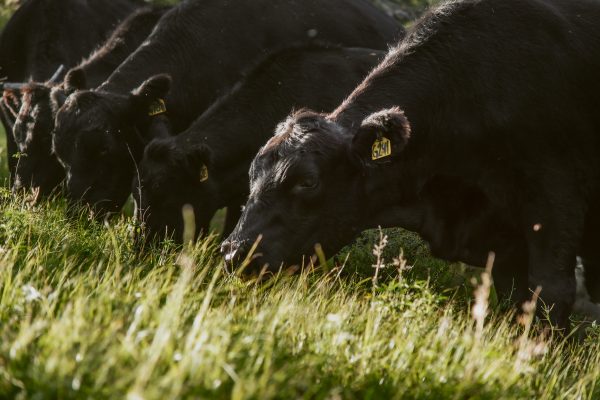
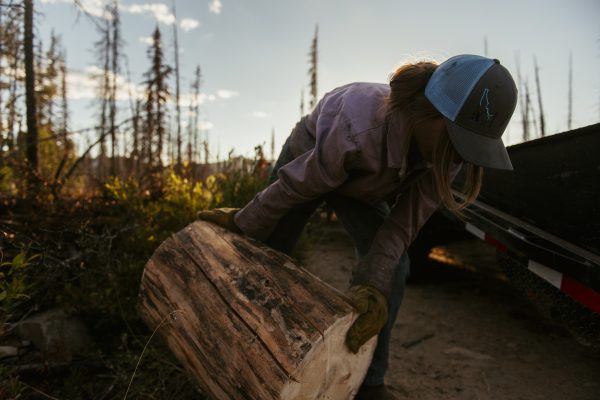
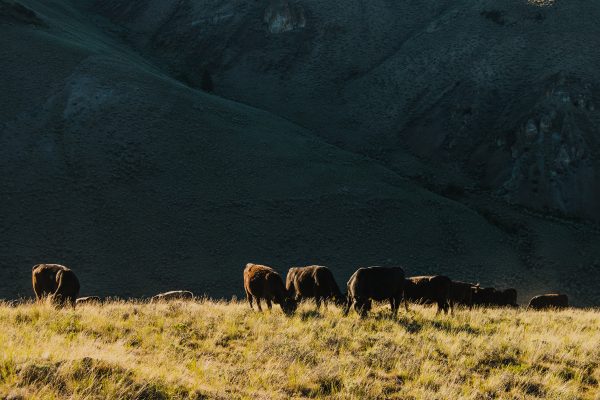


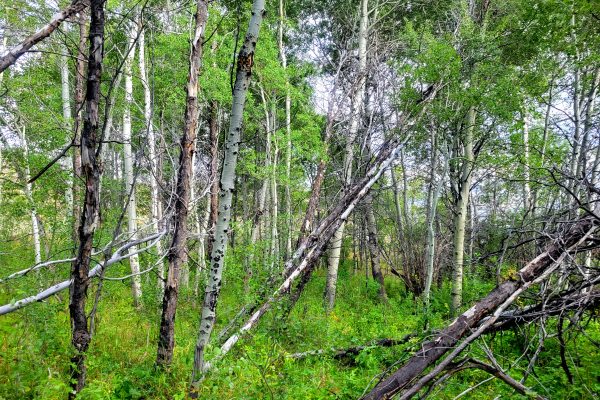
Deb Olsen
It’s amazing to me the research you’ve gone through to educate yourselves on how to perfectly work the land and all of the micro-nutrients plus learning how over grazing can strip the plants. I wished you could educate all farmers nationwide so we could be on the same page. Your knowledge, dedication and hard work are a true blessing. Thank you for all that you do.
Shirley
Unfortunately Deb, the rest of the farmers in this country are ruled by the almighty dollar. They are only concerned about making money. And they can’t even buy or use organic seeds to plant new crops. The laws passed by Congress (which were written by chemical lobbyists) prevent them from buying anything other than Genetically Modified seeds that can withstand the chemical fertilizers, herbicides, fungicides and weed killers that the big industrial companies sell.
So we are left with decisions to buy from organic farmers and from those who practice regenerative soil farming like Glenn and Caryl and family at Alderspring.
It will take many years to put more consumer dollars into organic foods and meats that have been grown on regenerative soils than into the “fake†food we find in grocery stores. But we have to start somewhere.
Leo Younger
Caring for life, loving the least of these, the soil and aquatic microbiomes which determine the success or failure of the internal life within us, is indeed our, ranchers and customers, reason for being here. The people who love gold more than other people are refusing to accept that love is always better for every life. All diseases and accidents are consequences of inadequacies or excesses, imbalances. The disease of the mind known as insatiable greed is endangering our species’ survival. The situation requires all our wisdom, knowledge, and understanding. Thank you, ranchers and customers.